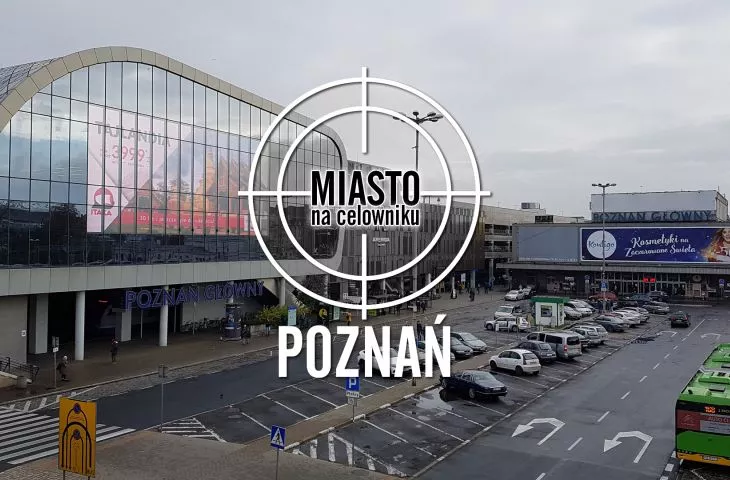For the past seven years, Poznań has been home to the country's largest escape room: the main train station. It's hard to get out of it - both toward Poznań's downtown and other cities. The local government and community activists are constantly fighting for the renovation of the old functional station building, but it is still unclear if and when the PKP will rise to the task.
What railroaders today call the station was opened just moments before EURO 2012, although just a few years earlier no one had planned to build a new station facility. Press polls and surveys conducted in 2007 showed only that Poznań residents wished for a thorough renovation of the old run-down station - a building from the 1880s, rebuilt so extensively after the war that it no longer resembled the original version. In 2007, however, Poznań became the organizer of three European Championship soccer matches and many things came to a head.
Reckless construction enthusiasm
The fever before EURO 2012 set in motion unreflective construction enthusiasm. Railroaders also succumbed to it. In 2008 they commissioned two Poznań studios to develop a concept for an Integrated Transportation Center connecting the PKP and PKS stations. Later, however, both commissioned and quite sensible concepts ended up in the trash, and PKP entered into an agreement with Hungarian developer TriGranit to build a station with an extensive shopping center. The international architectural firm BOSE was responsible for the project.
A shopping mall at the station was not previously in any plans, but the railroaders, together with TriGranit, did what they wanted. According to the Law on Planning and Zoning, the city has no say on the railroad site. Anyway, the magistrate did not seem concerned about the strange investment. On the contrary. It cheered it on and was happy about the mythical new jobs that another shopping center was to provide in a city already saturated with such facilities.
Dworcowy Square - general view; on the right, the old train station building
photo: Jakub Glaz
In June 2012, the new station building erected on pillars over the station's three eastern platforms was ready. After a few months, the PKP closed the old station. A year later, a huge shopping mall was opened attached to the new hulk, with a parking lot over the platforms, a small bus station with no direct connection to the PKP station (!) and a breakneck road layout by the city's road engineers.
Poznan's "breadbasket"
The new train station and mall were disappointing. They were only a shadow of the elegant visualizations from the BOSE studio.
"The whole thing is supposed to resemble the front of a modern locomotive," - Roman Biniszkiewicz of PKP Poznan told the press.
"It's more like a roller or a combine. In general, unfortunately, it is not architecture of the highest order." - commented art historian and architecture critic Jaroslaw Trybus.
In addition, the new building, which earned the nickname "breadbox" from its shape, was far less functional than its predecessor. This is because the old building stood in the middle of the station: the distances to the platforms on either side were similar. Convenient access was provided by the main hall, which was located at the level of the spacious station square. The platforms and the building were connected by a moderately convenient tunnel. Meanwhile, the new station gravitated toward one side and stood higher, above the tracks, at the level of the Station Bridge, to which it is connected by a narrow footbridge. To reach platforms 4, 5 and 6, located farther away, one had to climb high stairs, the station square and the old tunnel. To reach the nearest streetcar stop, one had to make up a solid distance: walk through a shopping mall, then through the new tunnel under Matya Street, and finally climb the stairs. To get to the platforms located under the station, you had to walk with suitcases up ordinary stairs, because the escalators only went up... There was also no real waiting room, and the platforms were finished to a standard worthy of a third-rate station. Everything was very unintuitive: in the tangle of stairs, passageways and corridors were lost not only travelers from other cities, but also Poznan citizens themselves.
The hall of the new station - escalators lead only to the top; until 2016 it was similar on the platforms
photo: Jakub Głaz
passengers vote with their feet
The misguided investment was fought mainly by community activists and the media, as the then mayor of the city, Ryszard Grobelny, failed to see its downsides. In interviews, he treated the station building as a relic in an era when tickets are bought online. He also objected to shortening the route to streetcar stops by several hundred (!) meters using a regular zebra. The reason? Alleged safety reasons.
In subsequent years, the situation improved slightly. The railroad commissioned an expert report, which showed errors visible to the naked eye. So, after a few years, a waiting room was built, visual navigation was improved, and an escalator was erected that also led downwards. The new city government, elected in 2014, also finally created a pedestrian crossing leading to the bus stops. Contrary to the Cassandrian opinions of Grobelny-era safety experts, so far no one has died on it, but passengers are voting for it with their feet. The underpass has been deserted.
A pedestrian crossing from the station to the stop, which shortened the way to the streetcar by several hundred meters (without having to climb stairs)
photo: Jakub Głaz
non-functional and cramped
Despite the improvements, the station still remained non-functional and cramped. It still hasn't been connected to the outlying platforms in a meaningful way, although a built-in footbridge was supposed to be built as early as 2013. So the city authorities, as well as the associations Investment for Poznań and Right to the City, continued to push for the renovation and reopening of the old station. In vain. PKP intended to erect a hotel and office buildings in the place of the old station. In 2015, it presented a project in which the historic facade of the station (from before the post-war reconstructions) is restored, and a completely new building with tall towers of office buildings and a hotel is built behind it. But contrary to earlier declarations, some space is planned for passenger service.
The project was not without skepticism, as the railroad's partner was again the infamous TriGranit. There were discussions, consultations and workshops based on the proposed design. But this concept too went into the trash in the fall of 2016, when the agreement with Hungary expired. The new management of the Polish State Railways (PKP) declared an independent renovation and restoration of the old station to full functionality by 2023 with EU money: already without skyscrapers and a hotel, but in a historical costume from the 19th century. Extensive public consultations were also planned.
Closed entrance to the old station from the tunnel under the platforms
photo: Jakub Głaz
future in the fog
Not a year went by, the board was dismissed and the future of the station began to shroud itself in an increasingly thick fog. True, the Poznań investment did not fall out of the (severely truncated) plan to modernize Poland's railway stations, but there was no longer any talk of consultations and a specific date. The Law and Justice Party-appointed governor only appointed a special team, to which, however, representatives of the City Hall were not invited.
Thus, in 2018, the magistrate declared its intention to take over the station building, explaining that the consortium of PKP and TriGranit failed to fulfill the participation agreement, which provided, among other things, for the construction of a footbridge, which has not been realized to this day. On the part of the railroad, instead, there were again announcements of investment with the participation of a private developer.
Bus station platforms under the shopping center (buses stand under a roof, passengers - under a cloud)
photo: Jakub Glaz
Earlier this year, it emerged that PKP decided to demolish the old building after all, and selected in a tender a company to design the new facility: Pas Projekt from Nadarzyn. The media and local architects were quick to report that the company had had several conflicts with the law and had failed to meet the challenge when designing the Gliwice transfer center. However, the railroaders did not give up on its services, and before this year's elections they again gave a construction date for the new station: 2023. Instead, they explained their tardiness in the design with alleged requirements from the city's conservation officer. To sweeten the deal, they instead announced the extension of the tunnel connecting the platforms. Only not, as the city would like, straight ahead, under the shopping center, to create a new eastern exit to downtown, but at an angle - to the hulking PKS station, which the city wants to abandon in the future anyway.
PKP has also moved ahead with the construction of a new platform, on a site once reserved for high-speed rail service. The snag is that the designation of the new platform will add to the chaos at the station. For years, the numbering of Poznań's platforms has been illogical. Suffice it to say that platform four follows the first, and 4a is de facto a separate station - the former Summer Station located behind an overpass, three hundred meters from the station.
The exit from one of the platforms to the station
photo: Jakub Głaz
Despite pressure from community activists, the railroaders claim that getting the numbering right is impossible. Since they are overwhelmed by this simple problem, it's hard to have any more hopes of restoring proper functionality to the entire station.









































































